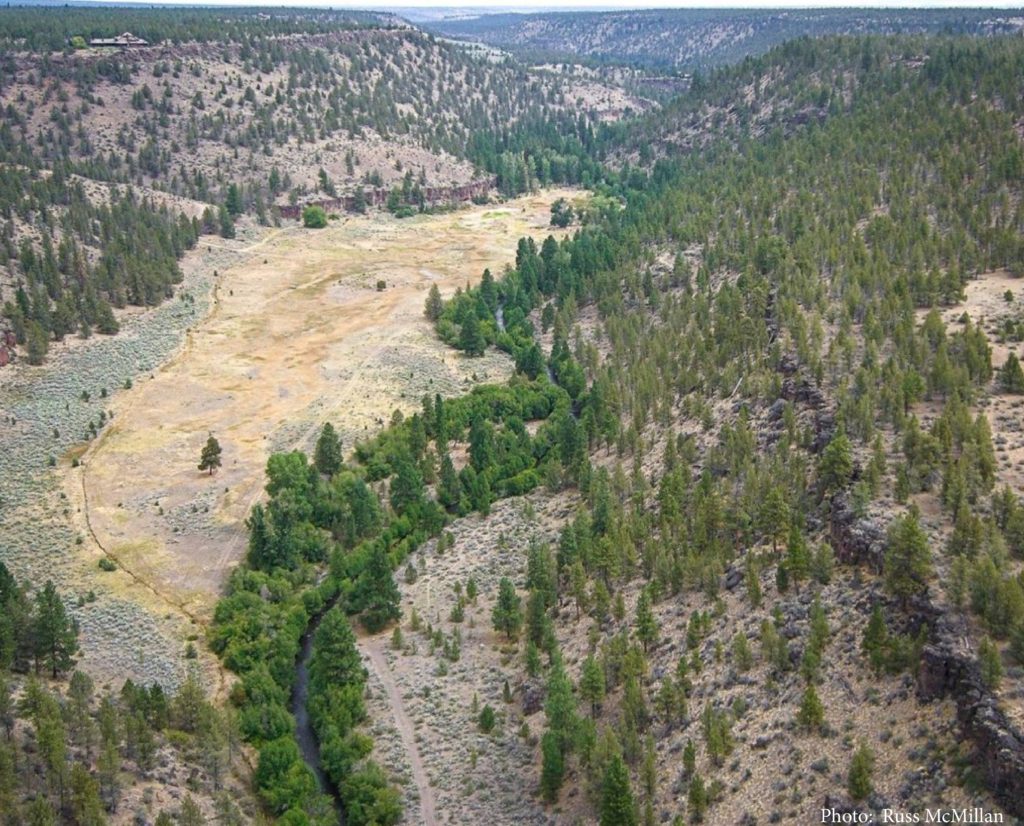Deschutes Land Trust’s Whychus Canyon Preserve
Although Whychus Creek provided important historic habitat for salmon, approximately 18 miles of channelization, water diversions and stream-side development have resulted in the loss of riparian habitat, channel complexity, floodplain connectivity and water quality over the past 100 years. Currently approximately 90% of Whychus Creek’s overall length functions as a sediment transport reach where the creek is either naturally confined in a canyon or artificially confined by berms.
Meadow reaches functioning as sediment depositional areas comprise only eight miles of Whychus Creek’s entire 41 mile length (< 20%). While low gradient reaches are less than 20% of the total length of Whychus Creek, more than 50% of the six-mile Whychus Canyon reach provides opportunities to restore functioning low gradient meadow reaches. The importance of these meadow habitats cannot be overstated because they were historically the most productive/diverse for aquatic and terrestrial species.
In its current condition, however, the six-mile reach through Whychus Canyon provides very poor habitat because channelization has decreased fish habitat, increased erosion, and eliminated floodplain connection that supported the meadow and wetland ecosystems once present. Without significant stream channel restoration, Whychus Creek will not reach its full potential for spawning fish that return to the area as passage is provided at the Pelton Round Butte Dams.
The overall goal of the project is to restore six miles of Whychus Creek, 3.6 miles of which will consist of restored meadow habitat, and its associated floodplain to provide high quality salmon, steelhead and trout spawning and rearing habitat as well as wetland and riparian habitat for resident and migratory wildlife. The project will restore the key functions and values of the historic wet meadows and associated in-stream and riparian habitats.
Over a mile of Whychus Creek was re-connected to its floodplain in the first phase of a six mile channel and habitat restoration project at Whychus Canyon in summer and fall of 2016. While monitoring will continue in the years to come, planning is underway for phase two restoration in 2019.

Specific goals include:
- Restore dynamic hydrologic function including floodplain connectivity, elevated shallow groundwater table, and sediment/nutrient storage. Dynamic hydrologic function includes but is not limited to:
- Development of vertical and horizontal variability on the floodplain;
- Activation of channels and floodplains at various flows; and
- Supporting a changing channel pattern that occurs through avulsion and formation of oxbows, point bars and mid‐channel bars;
- Provide dynamic, abundant and high quality diverse habitat including slot pools, pocket pools, alcoves, mid-channel pools, backwater areas, glides, and riffles for redband trout, Chinook salmon, steelhead and bull trout.
- Restore a diversity of riparian, wetland and wet meadow habitat for wildlife.
- Eliminate the threats to fish posed by the existing fish passage barriers and unscreened diversions.
The Upper Deschutes Watershed Council and its partners completed a restoration design for the 6 mile project reach in 2014 and match funding is still be sought for the first phase of implementation scheduled to begin in 2015. This multi-year restoration project is anticipated to take approximately 7 years to complete based on available funding.
For an update on the restoration work that has taken place on the Whychus Canyon Preserve, please visit our StoryMap “Towards Stage Zero: Restoring the Whychus Creek Riverscape“.
Project Partners and Funders include:
Deschutes Land Trust
Deschutes National Forest
Deschutes River Conservancy
Oregon Watershed Enhancement Board
Pelton Round Butte Fund
US Fish and Wildlife Service
